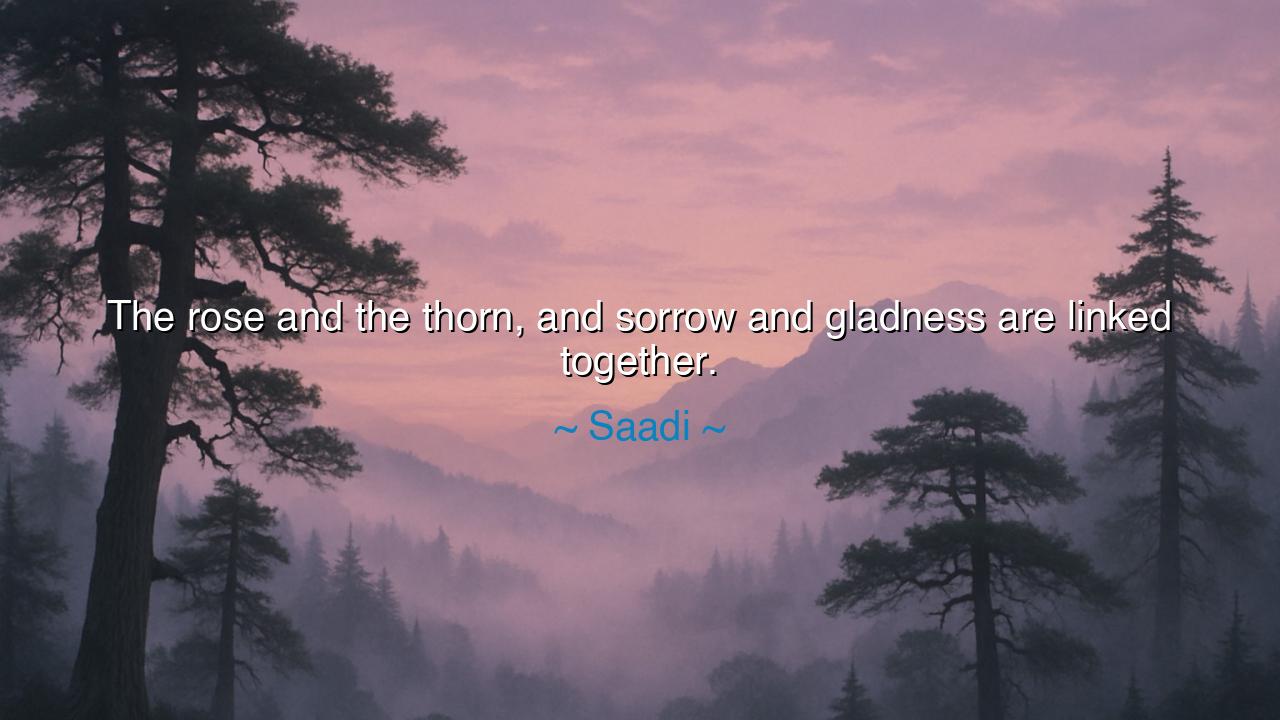
The rose and the thorn, and sorrow and gladness are linked






The Persian sage and poet Saadi of Shiraz, whose wisdom has outlived empires and echoed through the centuries, once wrote: “The rose and the thorn, and sorrow and gladness are linked together.” In this simple yet profound saying lies a truth older than the mountains and deeper than the sea—the truth that beauty and pain, joy and sorrow, are not opposites but companions. Just as the rose cannot exist without its thorn, so too can no soul experience true happiness without first having known the ache of grief. The world, in all its mystery, is woven from both fragrance and wound, and it is only through their union that life becomes whole.
The origin of this quote comes from Saadi’s timeless masterpiece, the Gulistan, or The Rose Garden, a work that blends moral reflection with poetic grace. Saadi lived in the thirteenth century, an age of both wonder and warfare, when Persia was rich with culture but shadowed by strife. He had wandered far across deserts and seas, learning from kings and beggars alike. From this life of experience, he came to see that joy is never unaccompanied, that even in laughter there is longing, and in sorrow, the seed of renewal. His words reflect the balance of existence—the eternal dance between sweetness and suffering that gives the world its depth and color.
Consider the rose itself, that ancient symbol of love and beauty. The delicate bloom enchants the senses, but its stem guards itself with sharp thorns. Those who seek to grasp its loveliness must do so with care, for pleasure and pain are twined upon the same branch. Saadi saw in this a divine parable: that all things precious in life come with risk, that love cannot be had without vulnerability, and that the path to joy must pass through the garden of endurance. To flee from pain entirely is to deny oneself the fragrance of the rose.
This truth has revealed itself throughout history, even in the lives of the great. Consider Helen Keller, who was both blind and deaf from infancy. The world might have assumed her life would be one of endless darkness and silence. Yet from her suffering grew a light that inspired millions. Her achievements, her joy, her wisdom—all were born from the soil of adversity. Her life embodied Saadi’s teaching: that sorrow and gladness are not enemies, but partners in the shaping of the soul. From the thorn of limitation grew the rose of insight, and through pain, she found a beauty beyond the physical.
The wisdom of Saadi reminds us, too, of the natural order of all things. After every night comes dawn; after every storm, stillness. Even the heart’s wounds, though they sting, prepare it to hold greater compassion. The one who has suffered learns to see the pain of others, and in that empathy lies divine strength. Thus, sorrow refines joy, just as fire refines gold. Without the contrast, we would never recognize one from the other. Without tears, we would not understand laughter. Without the thorn, the rose would lose its meaning.
The lesson here is not to chase pleasure or flee pain, but to accept both as sacred teachers. When you feel sorrow, do not curse it—it is carving room within you for deeper joy. When you find gladness, cherish it, knowing it is fleeting and therefore precious. Life’s beauty lies in this balance, in the eternal rhythm of rise and fall, bloom and wither, light and shadow. Those who learn to walk calmly through both are the ones who truly live.
To live wisely, then, is to embrace the whole garden of existence—to touch both the rose and the thorn with gratitude. Let your heart be vast enough to hold both pain and joy without despair. When you suffer, remember that you are being refined; when you rejoice, remember the humility that sorrow once taught you. In this way, every moment—whether bitter or sweet—becomes part of the divine harmony of life.
Thus, let the words of Saadi of Shiraz be your compass: “The rose and the thorn, and sorrow and gladness are linked together.” Do not wish for a life without thorns, for it would also be a life without roses. Instead, learn to walk among them with grace. Let each wound teach tenderness, and each joy teach gratitude. For it is only by embracing both the pain and the beauty of this world that one comes to know the fullness of being—and the peace that lies at the heart of all things.






AAdministratorAdministrator
Welcome, honored guests. Please leave a comment, we will respond soon